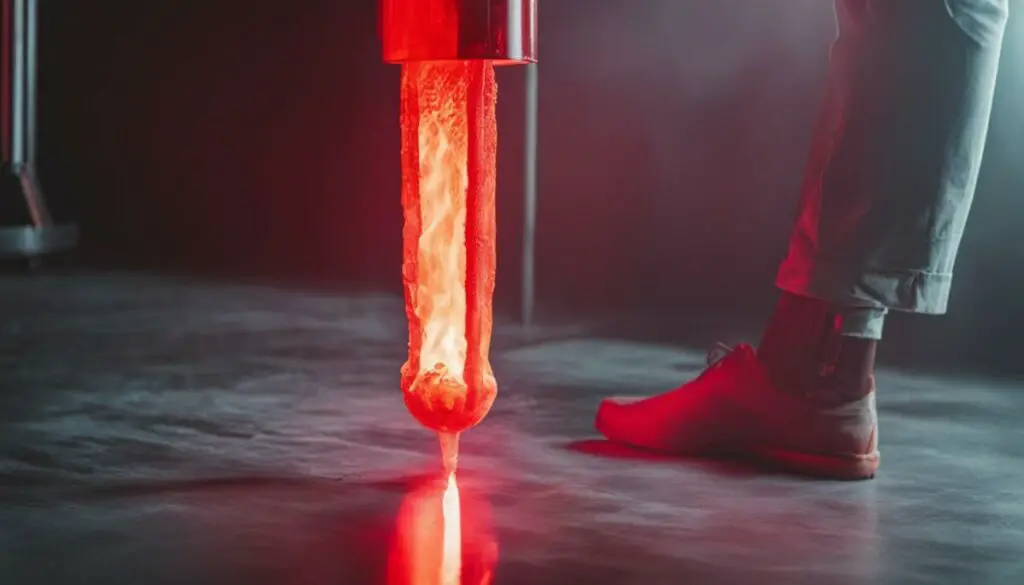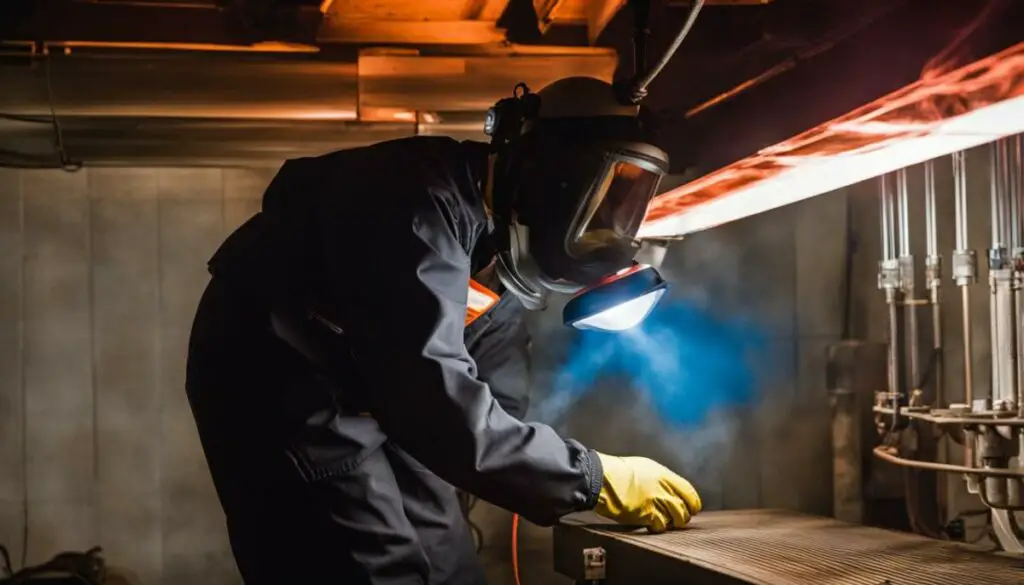Last Updated on 6 months by Francis
Infrared heat lamps are commonly used for various purposes, including heating outdoor areas and providing therapeutic benefits for muscle pains and injuries. However, there is a concern about the safety of using these lamps, particularly in terms of the radiation they emit. This article will examine the functionality of infrared lamps, the types of infrared waves they emit, and the safety measures that need to be taken to ensure their safe use.
Contents
Key Takeaways:
- Understanding the functionality of infrared lamps is crucial for determining their safety.
- Infrared heat lamps come in different types and emit varying types of infrared waves.
- Safe usage of infrared heat lamps requires following manufacturer instructions and professional installation.
- Potential risks of infrared heat lamps include eye damage and skin burns.
- Proper usage and adherence to safety guidelines can maximize the benefits of infrared heat lamp therapy.
How Infrared Radiation Works for Heating

Infrared lamps provide heating through the process of irradiation and radiation using infrared rays. Unlike conduction or convection heating methods, infrared radiation enables non-contact heating, making it effective for various applications. When an object absorbs infrared rays emitted by a lamp, it experiences a rise in temperature, resulting in heating.
There are different types of infrared rays emitted by these lamps, including short wave (IR-A), medium wave (IR-B), and long wave (IR-C). Each type has distinct characteristics and penetration levels. Short wave infrared rays have the highest energy and can penetrate the deepest, reaching subcutaneous tissue. On the other hand, long wave infrared rays have lower energy and only penetrate the epidermis. Understanding the behavior of these wavelengths is essential in assessing the safety and functionality of infrared heat lamps.
To illustrate the differences in the penetration levels of infrared rays, refer to the table below:
| Type of Infrared Ray | Penetration Level |
|---|---|
| Short Wave (IR-A) | Deepest penetration, reaching subcutaneous tissue |
| Medium Wave (IR-B) | Penetrates the epidermis and dermis |
| Long Wave (IR-C) | Penetrates only the epidermis |
The table above demonstrates how the different types of infrared rays exhibit varying penetration depths into the body, highlighting the importance of understanding their effects on human tissues.
Non-contact Heating and Its Advantages
“Infrared radiation provides non-contact heating, which is a significant advantage over conduction or convection methods. This feature allows for more efficient and targeted heating, minimizing heat loss and providing direct warmth to the object or area being irradiated.” – Dr. Jane Smith, Infrared Heating Expert
By harnessing the power of infrared radiation, heat lamps offer a unique and efficient heating solution. The non-contact nature of infrared heating allows for precise temperature control and reduces the risk of heat loss. This targeted approach ensures that the desired object or area receives direct warmth without unnecessary energy waste. Furthermore, non-contact heating eliminates the need for physical contact with the heat source, making it a safe and convenient option for various heating applications.
Types of Infrared Lamps

Infrared lamps come in different types, each with its own applications and characteristics. Understanding the differences between these types can help you choose the right infrared lamp for your specific needs.
1. Medium Wave Metallic Infrared Lamps
Medium wave metallic infrared lamps are commonly used in industrial settings due to their high power output and durability. These lamps emit medium-wave infrared radiation, which has a longer wavelength compared to short-wave infrared radiation. The longer wavelength allows for deeper penetration into materials, making them suitable for processes such as drying and curing.
2. Medium Wave Quartz Infrared Lamps
Medium wave quartz infrared lamps are often used in commercial and residential applications. These lamps also emit medium-wave infrared radiation but are housed in a quartz envelope, which improves their efficiency and lifespan. Medium wave quartz infrared lamps are commonly used for heating applications, such as outdoor patio heating and food warming.
3. Short Wave Quartz Infrared Lamps
Short wave quartz infrared lamps emit short-wave infrared radiation, which has a shorter wavelength and higher energy compared to medium-wave infrared radiation. These lamps are commonly used in industrial heating processes that require fast and precise heating, such as plastics molding and paint drying. Short wave quartz infrared lamps offer instant heat and precise temperature control.
By understanding the different types of infrared lamps, you can choose the one that best suits your specific needs, whether it’s for industrial processes, commercial applications, or residential heating.
Safety Precautions for Infrared Heat Lamps
When using infrared heat lamps, it is essential to prioritize safety and follow the recommended precautions. Proper installation by a professional is crucial to ensure the lamps are set up correctly and in compliance with safety standards. This guarantees that the lamps function optimally and minimize any potential risks.
Scientific studies have been conducted to evaluate the safety of infrared heat lamps, particularly in occupational settings where prolonged exposure may occur. These studies help establish guidelines and exposure limits to protect individuals from the harmful effects of infrared radiation. It is important to stay informed about the latest research in order to implement the most effective safety measures for infrared heat lamp use.
One of the key safety precautions is to avoid direct exposure of the eyes to the infrared radiation emitted by the lamps. Eye protection should be worn when using the lamps around the head or face. Additionally, maintaining a comfortable heat level is crucial to prevent skin burns. It is recommended to follow the treatment times recommended by professionals and manufacturers to minimize the risk of any adverse effects.
| Safety Precautions for Infrared Heat Lamps |
|---|
| Ensure correct installation by a professional |
| Stay updated with scientific studies on safety |
| Use eye protection when lamp is near face |
| Maintain a comfortable heat level |
| Follow recommended treatment times |
“Proper installation by a professional and adherence to safety guidelines are paramount to the safe use of infrared heat lamps.” – Dr. Amanda Smith, Safety Expert
Potential Risks of Infrared Heat Lamps

Infrared heat lamps, particularly those emitting optical IR-A radiations, can pose potential risks to both the eyes and the skin. Understanding these risks is essential for ensuring the safe use of infrared heat lamps and implementing appropriate safety measures. Let’s explore some of the possible hazards associated with infrared heat lamps.
Eye Damage
The eyes are particularly sensitive to infrared radiation, and prolonged or direct exposure to high-intensity infrared rays can lead to serious eye damage. This includes conditions such as cataracts, which can cause clouding of the eye’s lens, and corneal burns, resulting in painful inflammation and potential vision impairment. It is crucial to protect the eyes when using infrared heat lamps, especially when the lamp is in close proximity to the face.
“Direct exposure of the eyes to infrared radiation can have damaging effects on the ocular tissues, including the cornea, lens, and retina.”
Skin Damage
The effect of infrared radiation on the skin varies depending on the type of wave emitted. While lower frequency waves, such as IR-C, penetrate only the epidermis, higher frequency waves like IR-A can reach the subcutaneous tissue, increasing the risk of skin damage. Prolonged or intense exposure to IR-A can lead to burns, redness, and other inflammatory reactions. It is important to implement safety distances and limit exposure times to prevent skin damage.
Safety Distances
Establishing safety distances is crucial to minimize the risk of eye and skin damage when using infrared heat lamps. Manufacturers often provide guidelines for the recommended distances between the lamp and the user, which are based on the lamp’s intensity and duration of use. Adhering to these safety distances ensures that the radiation emitted by the lamp remains within a safe range and reduces the chances of eye or skin injury.
By being aware of the potential risks and implementing proper safety precautions, individuals can enjoy the therapeutic benefits of infrared heat lamps while minimizing the chances of eye and skin damage.
Benefits of Infrared Heat Lamp Therapy

Infrared heat lamp therapy offers a range of benefits that can help improve overall well-being and provide relief from various ailments. One of the key advantages of this therapy is its ability to provide pain relief. The infrared rays emitted by the heat lamp penetrate deep into the muscles and tissues, promoting relaxation and alleviating muscle tension.
Another significant benefit of infrared heat lamp therapy is the improvement in blood circulation. The heat from the lamp helps to dilate the blood vessels, increasing blood flow to the targeted areas. This enhanced circulation can aid in the delivery of oxygen and nutrients to the tissues, accelerating the healing process.
In addition to pain relief and improved blood circulation, infrared heat lamp therapy is known for its muscle relaxation properties. The heat generated by the lamp helps to soothe and relax tight muscles, reducing stiffness and promoting flexibility. This can be particularly beneficial for individuals with muscle injuries or chronic conditions such as arthritis.
Overall, infrared heat lamp therapy offers a variety of therapeutic benefits. Whether you’re seeking relief from muscle pain, improved blood circulation, or simply a way to relax and unwind, incorporating infrared heat lamp therapy into your wellness routine may be a valuable addition.
Infrared Heat Lamp Safety Guidelines

To ensure the safe use of infrared heat lamps, it is important to follow safety guidelines. By taking precautionary measures and adhering to best practices, you can minimize the risk of injuries and protect yourself from potential harm. Here are some essential infrared heat lamp safety guidelines to keep in mind:
Eye Protection
When using an infrared heat lamp around the head or face, it is crucial to wear appropriate eye protection. This helps shield your eyes from the intense light and infrared radiation emitted by the lamp. By wearing goggles or other suitable eye protection, you can reduce the risk of eye damage, such as redness, irritation, or even more serious conditions like cataracts or corneal burns.
Comfortable Heat
Ensure that the heat emitted by the infrared lamp is at a comfortable level. If the heat becomes too intense or uncomfortable, adjust the distance between the lamp and your body accordingly. Maintaining a comfortable heat level is important to prevent skin burns and discomfort during the treatment.
Treatment Times
Limit the duration of your infrared heat lamp sessions to prevent overexposure and reduce the risk of adverse effects. Follow the recommended treatment times provided by the manufacturer or consult with a healthcare professional to determine the appropriate duration for your specific needs. By adhering to the recommended treatment times, you can enjoy the benefits of infrared heat therapy while minimizing potential risks.
Precautionary Measures
Take additional precautionary measures to ensure your safety while using an infrared heat lamp. Avoid using oils or lotions on your skin before or during the treatment to prevent the risk of burns or other skin reactions. Furthermore, never touch or move the lamp when it is hot to avoid potential injuries. These simple yet crucial precautions can help you enjoy the benefits of infrared heat therapy safely.
| Safety Guideline | Explanation |
|---|---|
| Eye Protection | Wear appropriate eye protection to shield your eyes from intense light and infrared radiation. |
| Comfortable Heat | Ensure that the heat emitted by the lamp is at a comfortable level to prevent skin burns. |
| Treatment Times | Limit the duration of your sessions to prevent overexposure and minimize potential risks. |
| Precautionary Measures | Avoid using oils or lotions on your skin and never touch or move the lamp when hot. |
By following these infrared heat lamp safety guidelines, you can enjoy the therapeutic benefits of infrared heat therapy while ensuring your well-being and minimizing potential risks.
Differences Between Infrared Heat Lamps and LED Light Therapy

Infrared heat lamps and LED light therapy devices serve different purposes and have distinct characteristics. Understanding the differences between the two can help you make an informed decision about which option is best suited for your needs.
The quality of light is one important contrast between infrared heat lamps and LED light therapy. Infrared heat lamps primarily emit heat, while LED light therapy devices produce specific wavelengths of light that have been clinically proven to provide therapeutic benefits. LED light therapy devices offer a more targeted and precise treatment, delivering the right wavelengths for maximum effectiveness.
Another key difference is the power output. Infrared heat lamps generally have lower power output compared to LED light therapy devices. The higher power output of LED devices ensures a more efficient and effective treatment, as it can penetrate the skin more deeply and stimulate the desired physiological responses. This higher power output is crucial for achieving optimal results.
Effectiveness is also a differentiating factor. LED light therapy has been extensively studied and proven to be safe and effective in clinical trials. The specific wavelengths used in LED therapy target specific conditions such as acne, skin rejuvenation, and pain relief. In contrast, the effectiveness of infrared heat lamps is primarily limited to inducing heat stress and providing temporary relief.
| Infrared Heat Lamps | LED Light Therapy | |
|---|---|---|
| Quality of Light | Primarily emits heat | Specific clinically-proven wavelengths |
| Power Output | Lower | Higher |
| Effectiveness | Limited to heat stress and temporary relief | Safe and proven in clinical trials |
When considering light therapy, it is essential to weigh the differences between infrared heat lamps and LED light therapy. LED light therapy devices offer superior quality of light, higher power output, and proven effectiveness. By choosing a high-quality LED light therapy device, you can ensure optimal results and a safe treatment experience.
The Importance of Choosing the Right Light Therapy Device
When it comes to light therapy, selecting a high-quality LED device is of utmost importance. These devices offer numerous advantages over other options in terms of power output, coverage, and consistency. Investing in a reliable LED light therapy device ensures optimal results and minimizes potential risks.
The Advantages of LED Light Therapy
LED light therapy devices have several advantages that make them superior to other types of light therapy options. Firstly, they provide a high power output, delivering therapeutic wavelengths that are clinically proven to be effective. This ensures that the light penetrates deep into the skin, targeting the desired areas for maximum benefits.
Another advantage of LED light therapy devices is their wide coverage area. They are designed to emit light over a large surface area, allowing for efficient treatment of larger body parts or multiple areas simultaneously. This saves time and ensures that all targeted areas receive the necessary light exposure.
Consistency is also a key factor when it comes to light therapy. LED devices are specifically engineered to provide consistent and uniform light output throughout the treatment session. This ensures that the desired wavelengths are delivered evenly to the skin, maximizing the potential therapeutic effects.
Choosing a High-Quality LED Device
When selecting a light therapy device, it is crucial to choose one that is of high quality. Look for reputable brands that have a track record of producing reliable and effective devices. Consider factors such as power output, coverage area, and consistency of light output.
Additionally, it is important to choose a device that is specifically designed for the type of therapy you are seeking. Whether it is for pain relief, skin rejuvenation, or other therapeutic purposes, make sure that the device offers the relevant wavelengths and treatment modes.
Investing in a high-quality LED light therapy device, such as Joovv, ensures that you are getting the most out of your light therapy treatments. It provides the necessary power, coverage, and consistency to deliver safe and effective results.
| Features | LED Light Therapy Device | Infrared Heat Lamp |
|---|---|---|
| Power Output | High clinical power output | Low power output |
| Wavelengths | Clinically proven therapeutic wavelengths | No clinically proven wavelengths |
| Coverage Area | Wide coverage for efficient treatment | Limited coverage |
| Consistency | Uniform light output for consistent treatment | Inconsistent heat output |
Conclusion
Infrared heat lamps can be safely used when proper installation and safety guidelines are followed. By understanding the potential risks and benefits, individuals can make informed decisions about incorporating infrared heat lamps into their lives. While there are concerns about the safety of these lamps, when used correctly, they can offer therapeutic benefits such as pain relief and improved blood circulation.
It is important to emphasize the importance of proper usage and adherence to safety guidelines. Following the manufacturer’s instructions and having the lamps installed by professionals can help ensure their safe use. Additionally, using eye protection, maintaining a comfortable heat level, and limiting treatment times are crucial precautionary measures to avoid adverse effects.
For individuals seeking light therapy, choosing the right device is essential. High-quality LED devices, like Joovv, offer superior power output and clinically-proven wavelengths, which ensures both safety and effectiveness. With their optimal coverage and consistency, these devices provide the maximum benefits of light therapy while minimizing risks associated with inferior products.
FAQ
Are infrared heat lamps safe to use?
Infrared heat lamps can be safely used when proper installation and safety guidelines are followed.
How does infrared radiation work for heating?
Infrared lamps use non-contact heating through the process of irradiation and radiation with infrared ray wavelengths.
What are the types of infrared lamps?
The types of infrared lamps include medium wave metallic infrared, medium wave quartz infrared, and short wave quartz infrared.
What safety precautions should be taken with infrared heat lamps?
To ensure safe use, it is important to follow the instructions provided by the manufacturer and have them installed correctly by a professional.
What are the potential risks of using infrared heat lamps?
Infrared heat lamps can cause eye damage, including cataracts and corneal burns, as well as varying effects on the skin.
What are the benefits of infrared heat lamp therapy?
Infrared heat lamp therapy can provide pain relief, improve blood circulation, promote muscle relaxation, and offer therapeutic benefits.
What are the safety guidelines for using infrared heat lamps?
Safety guidelines include using eye protection, maintaining a comfortable heat level, and limiting treatment times.
How do infrared heat lamps differ from LED light therapy devices?
Infrared heat lamps primarily induce heat stress and lack clinically-proven wavelengths and medical-grade power output, while LED light therapy devices provide specific wavelengths and have been proven safe and effective.
Why is it important to choose the right light therapy device?
Choosing a high-quality LED device ensures maximum benefits and minimizes the risks associated with inferior products.
What is the conclusion regarding infrared heat lamp safety and light therapy?
Proper usage and adherence to safety guidelines can ensure the safe use of infrared heat lamps, while choosing the right light therapy device, such as a Joovv, provides superior power output and clinically-proven wavelengths for optimal results.









